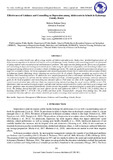| dc.contributor.author | Bakesia, Grace Buluma | |
| dc.contributor.author | Abwalaba, Roselyne | |
| dc.date.accessioned | 2023-09-25T10:19:06Z | |
| dc.date.available | 2023-09-25T10:19:06Z | |
| dc.date.issued | 2023-08-16 | |
| dc.identifier.uri | https://ajernet.net/ojs/index.php/ajernet/article/view/98 | |
| dc.identifier.uri | https://doi.org/10.51867/ajernet.4.2.22 | |
| dc.identifier.uri | http://ir-library.mmust.ac.ke:8080/xmlui/handle/123456789/2283 | |
| dc.description.abstract | Depression is a solemn health issue affects a large number of children and adolescents. Studies have identified high prevalence of depression among adolescent students in Kenya as well as in Kakamega County. Guidance and counselling practices are functional in aiding students with a myriad of social and behavioural problems. This study aimed at finding out the effectiveness of guidance and counselling on depression management and the factors influencing the effectiveness of guidance and counselling in depression management among adolescents in secondary schools in Kakamega County. The study was guided by pretest/post-test design to a target 442 secondary schools, 442 heads of guidance and counselling department and 180,851 adolescents from secondary schools in Kakamega County. Multistage cluster sampling was used to select the 45 schools. Purposive sampling was used to select 45 Guidance and Counselling teachers. 91 adolescents were sampled purposively from a 448-sample calculated by G~power. Data was collected using three sets of tools; Kutcher Adolescent Depression Scale, sociodemographic questionnaire, and a key informant guide for the head of guidance and counselling and education officers. Pilot study was done in the neighbouring County before commencement of actual data collection. Data was analysed using statistical package for social sciences (SPSS) version 27.0. Quantitative data was analysed using descriptive and inferential statistics and presented as in tables and charts as percentages and means. Qualitative data was analysed thematically. Results showed that guidance and counselling have a small effect on depression levels. The findings showed that G&C was more effective for the male adolescents (OR=1.7; Cl=0.89, 2.56; p<0.001), those in boarding schools (OR=1.7; Cl=0.89, 2.56; p<0.001) and those of the Christian faith – integrate these findings here. The study recommends that other effective interventions should be put in place to manage depression for adolescents in schools. | en_US |
| dc.language.iso | en | en_US |
| dc.publisher | AFRICAN JOURNAL OF EMPIRICAL RESEARCH | en_US |
| dc.subject | Effectiveness of Guidance and Counselling on Depression among Adolescents in Schools in Kakamega County, Kenya | en_US |
| dc.title | Effectiveness of Guidance and Counselling on Depression among Adolescents in Schools in Kakamega County, Kenya | en_US |
| dc.type | Article | en_US |

